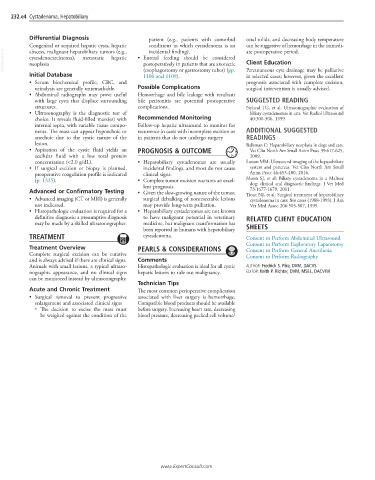Page 520 - Cote clinical veterinary advisor dogs and cats 4th
P. 520
232.e4 Cystadenoma, Hepatobiliary
Differential Diagnosis patient (e.g., patients with comorbid total solids, and decreasing body temperature
Congenital or acquired hepatic cysts, hepatic conditions in which cystadenoma is an can be suggestive of hemorrhage in the immedi-
VetBooks.ir cystadenocarcinoma), metastatic hepatic • Enteral feeding should be considered Client Education
incidental finding).
ate postoperative period.
abscess, malignant hepatobiliary tumors (e.g.,
neoplasia
postoperatively in patients that are anorectic
Initial Database (esophagostomy or gastrostomy tubes) (pp. Percutaneous cyst drainage may be palliative
1106 and 1109).
in selected cases; however, given the excellent
• Serum biochemical profile, CBC, and prognosis associated with complete excision,
urinalysis are generally unremarkable. Possible Complications surgical intervention is usually advised.
• Abdominal radiographs may prove useful Hemorrhage and bile leakage with resultant
with large cysts that displace surrounding bile peritonitis are potential postoperative SUGGESTED READING
structures. complications. Nyland TG, et al: Ultrasonographic evaluation of
• Ultrasonography is the diagnostic test of biliary cystadenomas in cats. Vet Radiol Ultrasound
choice. It reveals fluid-filled mass(es) with Recommended Monitoring 40:300-306, 1999.
internal septa, with variable tissue compo- Follow-up hepatic ultrasound to monitor for
nents. The mass can appear hypoechoic or recurrence in cases with incomplete excision or ADDITIONAL SUGGESTED
anechoic due to the cystic nature of the in patients that do not undergo surgery READINGS
lesion. Balkman C: Hepatobiliary neoplasia in dogs and cats.
• Aspiration of the cystic fluid yields an PROGNOSIS & OUTCOME Vet Clin North Am Small Anim Pract 39:617-625,
acellular fluid with a low total protein 2009.
concentration (<2.0 g/dL). • Hepatobiliary cystadenomas are usually Larson MM: Ultrasound imaging of the hepatobiliary
• If surgical excision or biopsy is planned, incidental findings, and most do not cause system and pancreas. Vet Clin North Am Small
preoperative coagulation profile is indicated clinical signs. Anim Pract 46:453-480, 2016.
(p. 1325). • Complete tumor excision warrants an excel- Moon SJ, et al: Biliary cystadenoma in a Maltese
lent prognosis. dog: clinical and diagnostic findings. J Vet Med
Advanced or Confirmatory Testing • Given the slow-growing nature of the tumor, 73:1677-1679, 2011.
• Advanced imaging (CT or MRI) is generally surgical debulking of nonresectable lesions Trout NJ, et al: Surgical treatment of hepatobiliary
cystadenoma in cats: five cases (1988-1993). J Am
not indicated. may provide long-term palliation. Vet Med Assoc 206:505-507, 1995.
• Histopathologic evaluation is required for a • Hepatobiliary cystadenomas are not known
definitive diagnosis; a presumptive diagnosis to have malignant potential in veterinary RELATED CLIENT EDUCATION
may be made by a skilled ultrasonographer. medicine, but malignant transformation has
been reported in humans with hepatobiliary SHEETS
TREATMENT cystadenoma. Consent to Perform Abdominal Ultrasound
Consent to Perform Exploratory Laparotomy
Treatment Overview PEARLS & CONSIDERATIONS Consent to Perform General Anesthesia
Complete surgical excision can be curative Consent to Perform Radiography
and is always advised if there are clinical signs. Comments
Animals with small lesions, a typical ultraso- Histopathologic evaluation is ideal for all cystic AUTHOR: Fredrick S. Pike, DVM, DACVS
nographic appearance, and no clinical signs hepatic lesions to rule out malignancy. EDITOR: Keith P. Richter, DVM, MSEL, DACVIM
can be monitored instead by ultrasonography.
Technician Tips
Acute and Chronic Treatment The most common perioperative complication
• Surgical removal to prevent progressive associated with liver surgery is hemorrhage.
enlargement and associated clinical signs Compatible blood products should be available
○ The decision to excise the mass must before surgery. Increasing heart rate, decreasing
be weighed against the condition of the blood pressure, decreasing packed cell volume/
www.ExpertConsult.com

